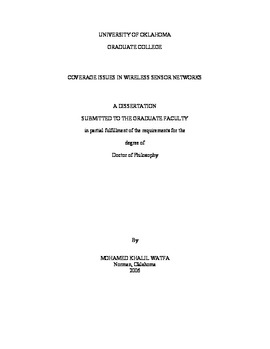| dc.contributor.advisor | Commuri, Sesh, | en_US |
| dc.contributor.author | Watfa, Mohamed Khalil. | en_US |
| dc.date.accessioned | 2013-08-16T12:20:10Z | |
| dc.date.available | 2013-08-16T12:20:10Z | |
| dc.date.issued | 2006 | en_US |
| dc.identifier.uri | https://hdl.handle.net/11244/1047 | |
| dc.description.abstract | A fundamental issue in the deployment of a large scale Wireless Sensor Network (WSN) is the ability of the network to cover the region of interest. While it is important to know if the region is covered by the deployed sensor nodes, it is of even greater importance to determine the minimum number of these deployed sensors that will still guarantee coverage of the region. This issue takes on added importance as the sensor nodes have limited battery power. Redundant sensors affect the communications between nodes and cause increased energy expenditure due to packet collisions. While scheduling the activity of the nodes and designing efficient communication protocols help alleviate this problem, the key to energy efficiency and longevity of the wireless sensor network is the design of efficient techniques to determine the minimum set of sensor nodes for coverage. Currently available techniques in the literature address the problem of determining coverage by modeling the region of interest as a planar surface. Algorithms are then developed for determining point coverage, area coverage, and barrier coverage. The analysis in this thesis shows that modeling the region as a two dimensional surface is inadequate as most applications in the real world are in a three dimensional space. The extension of existing results to three dimensional regions is not a trivial task and results in inefficient deployments of the sensor networks. Further, the type of coverage desired is specific to the application and the algorithms developed must be able to address the selection of sensor nodes not only for the coverage, but also for covering the border of a region, detecting intrusion, patrolling a given border, or tracking a phenomenon in a given three dimensional space. These are very important issues facing the research community and the solution to these problems is of paramount importance to the future of wireless sensor networks. In this thesis, the coverage problem in a three dimensional space is rigorously analyzed and the minimum number of sensor nodes and their placement for complete coverage is determined. Also, given a random distribution of sensor nodes, the problem of selecting a minimum subset of sensor nodes for complete coverage is addressed. A computationally efficient algorithm is developed and implemented in a distributed fashion. Numerical simulations show that the optimized sensor network has better energy efficiency compared to the standard random deployment of sensor nodes. It is demonstrated that the optimized WSN continues to offer better coverage of the region even when the sensor nodes start to fail over time. (Abstract shortened by UMI.) | en_US |
| dc.format.extent | xviii, 240 leaves : | en_US |
| dc.subject | Sensor networks. | en_US |
| dc.subject | Engineering, Electronics and Electrical. | en_US |
| dc.subject | Computer Science. | en_US |
| dc.subject | Mobile computing. | en_US |
| dc.title | Coverage issues in wireless sensor networks. | en_US |
| dc.type | Thesis | en_US |
| dc.thesis.degree | Ph.D. | en_US |
| dc.thesis.degreeDiscipline | School of Electrical and Computer Engineering | en_US |
| dc.note | Adviser: Sesh Commuri. | en_US |
| dc.note | Source: Dissertation Abstracts International, Volume: 67-04, Section: B, page: 2164. | en_US |
| ou.identifier | (UMI)AAI3215141 | en_US |
| ou.group | College of Engineering::School of Electrical and Computer Engineering | |
